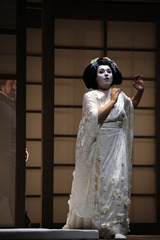| Opera Reviews | 26 April 2024 |
La Scala's 'original' Butterfly is enthusiastically receivedby Silvia Luraghi |
|
| Puccini: Madama Butterfly Teatro alla Scala, Milan 13 December 2016 |
|
|
Despite the defection of national politicians, due to the recent government crisis, the performance was attended by a crowded audience including various celebrities and numerous opera fans (provided they could afford the extra expensive tickets), attracted by the rarity of the opening title: the original 1904 version of Giacomo Puccini’s Madama Butterfly, which had premiered at La Scala and was a big fiasco. Following the negative reception, Puccini revised the opera, and changed it to the world renowned audience favorite we are used to hearing today. Most changes concern the theatrical structure of the opera: the original version was divided into two acts, the second act corresponding to the second and third act of the current version. This created an imbalance, as the second act was one and half hours long, and Puccini decided to divide it into two acts with an intermezzo. In addition, the composer left out some short, partly caricature, scenes of Japanese life, such as the drunken song of Yakusidé or various remarks by Cio-Cio-San’s relatives. More important, Cio-Cio-San’s part was slightly cut, leaving out various considerations on how she decided to accept Pinkerton’s marriage proposal during the first act love duet, and her encounter with Kate Pinkerton in the second act was substantially changed, as the latter became a mute character, while she had a short but important vocal role in the original. In a short confrontation between the two women it was Kate Pinkerton who asked Cio-Cio-San to give her her son, explaining that she had married Pinkerton. Also cut is a brief dialogue in which Sharpless tried to give Cio-Cio-San some money from Pinkerton (the woman refuses to accept it). Also in the new version of the opera, Pinkerton acquired the aria ‘Addio fiorito asil’ and with it an opportunity to show some regret, which he didn’t seem to feel in the original version. In general, the current version seems more compact and compelling, but this might be an effect of being accustomed to it, and one is indeed tempted to agree with Puccini and Ricordi, who talked of an impending disaster. For the occasion, the company presented a new production directed by Alvis Hermanis, with the stage completely occupied by a Japanese house with sliding rice-paper doors on three levels designed by Hermanis in collaboration with Leila Fteita, and the singers in colorful kimonos by costume designer Kristine Jurjāne. A group of geishas in white dance on the upper levels accompanying various moments of the performance with kabuki moves. In the background, Nagasaki bay appears in pale colors. Only at the opening of the second act the interior of Cio-Cio-San’s living room features western furniture, with the woman working with a western sewing machine, to show her desire to conform to her husband’s world. Opening night was broadcast on public TV and reached over 2.5 million people. In the title role, soprano Maria José Siri sang with commitment and enjoyed a great success. At the Dec. 13th performance, she was announced to be indisposed. However she sang with touching delicacy, keeping her vocal volume somewhat limited, but still mastering the score without flaws. Tenor Bryan Hymel was much less compelling: he had to force his voice, and sometimes did not feel at ease with his diction. Baritone Carlos Álvarez was luxury casting for Sharpless, both vocally and theatrically. But the real star of the performance was conductor Riccardo Chailly, one of the most important Puccini specialists, who had decided to revive this rarely performed version of the opera, and was able to make it compelling for the enthusiastic audience.
|
|
| Text ©
Silvia Luraghi Photo Brescia/Amisano © Teatro alla Scala |

 The 2016-17 season opened traditionally at La Scala on December 7th, the day devoted to Milan’s patron Saint Ambrose.
The 2016-17 season opened traditionally at La Scala on December 7th, the day devoted to Milan’s patron Saint Ambrose. 





